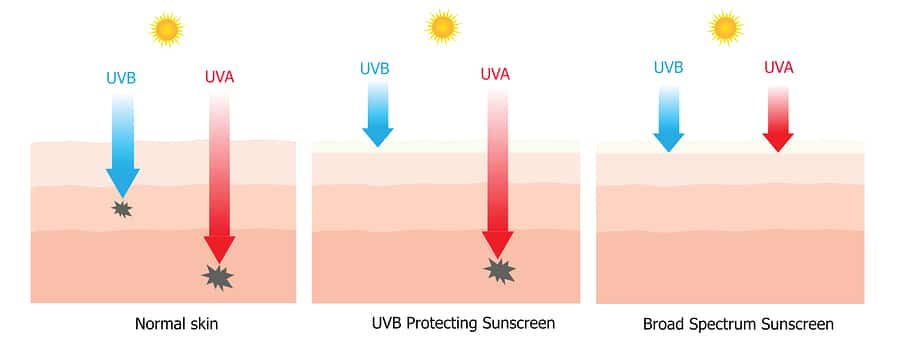Ultraviolet Rays and Sunscreens
As restorative and harmless as the sun probably appears to you at first glance, reality can be another matter entirely. Contained within its warming rays are two types of ultraviolet rays, UVA and UVB. Both are invisible to the naked eye, and both can be a potential threat to your skin. They are part of the light spectrum that reaches the earth through radiation and can injure your skin through prolonged, unprotected exposure.
The shorter wave, UVB can burn your skin, causing it to age prematurely. The longer ray, UVA, in addition to the other possible effects, can cause even more lasting skin damage. This is why sunscreens were created to help you avoid these potentially dangerous conditions.

You will always hear myths about the effectiveness of sunscreens, but, despite the rumors you have heard about their safety, they still offer you the best single protection against the effects of the ultraviolet rays of the sun. In one recent study, the application of sunscreen with an SPF of 16 significantly reduced the risk of melanoma (skin cancer).
When you pick up a bottle of sunscreen, notice the combination of ingredients, rated by their SPF (Sun Protective Factor). The rating indicates how well it protects you from the sun’s ultraviolet rays. The sooner skin reddens, based on exposure, the more protection (SPF) you will need. Even on a cloudy day, a high percentage of ultraviolet rays can reach your skin.
Drugstores offer a variety of sunscreens, from 15 SPF to surpassing 70 SPF. They can be labeled “broad spectrum.” This means that they protect you from both types of ultraviolet rays. The American Academy of Dermatology recommends that you choose a sunscreen of at least SPF 30.
Depending upon where you want to apply your sunscreen, there are many options, including creams for your face and dry skin, gels for hairy areas like men’s chests, specialized sprays for your babies and people with sensitive skin. When using sprays, you should be sure to avoid inhalation during application.
Be careful. Not all sunscreens are alike. When you purchase one, be sure to read the label carefully. Your sunscreens should be either marked Water Resistant (effective up to 40 minutes in water) or Very Water Resistant (up to 80 minutes). Make certain that your sunscreen is a broad spectrum product for maximum protection.
There is no research available to support any claim that sunscreens with an SPF rating higher than 50 are any more effective for you than those with an SPF 50. Even a sunscreen rated SPF 30 will block 97% of the sun’s harmful rays if you apply it properly.
Most people actually apply less than the proper amount needed to protect them. You shouldn’t be one of them. Dermatologists recommend using plenty of sunscreen to cover all of your exposed skin surfaces, about enough to fill a shot glass.
Another important thing to remember is that, like any other medicines, sunscreens have an expiration date. If your sunscreen reaches its expiration date, don’t take any chances. Throw it out and buy another one. The cost is minimal and you will be sure of its protective strength before going out in the sun.
In addition to wearing sunscreen, there are several other common sense things you can do to protect your skin. Wear protective clothing. Avoid tanning beds. Take vitamin D on a regular basis. Stay in the shade. These are a few simple suggestions for you, but they are not always feasible. When used properly, sunscreens offer you a viable alternative to protect you from the sun’s harmful rays.







